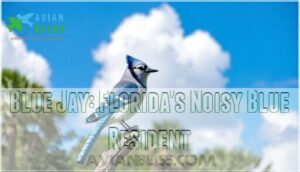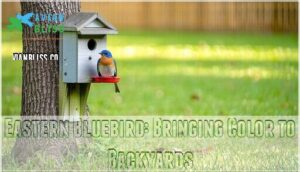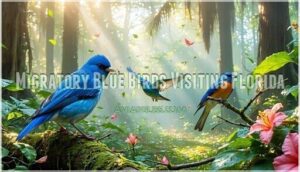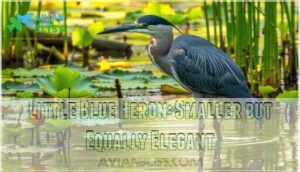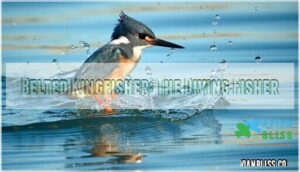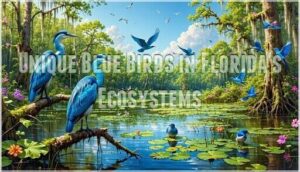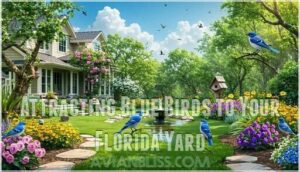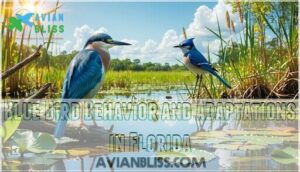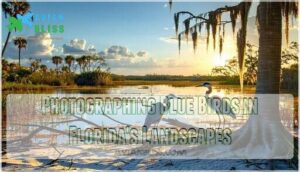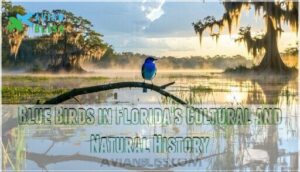This site is supported by our readers. We may earn a commission, at no cost to you, if you purchase through links.
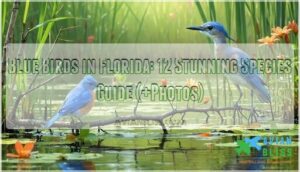
The noisy Blue Jay rules suburban neighborhoods, while the endangered Florida Scrub-Jay sticks to sandy scrublands.
Eastern Bluebirds brighten open fields, and Great Blue Herons wade through wetlands like feathered fishermen.
During migration seasons, you can spot Indigo Buntings and Tree Swallows adding their own splash of azure to the mix.
Purple Gallinules tiptoe across lily pads, and the rare Cerulean Warbler occasionally graces treetops.
From your backyard to state parks, these blue birds in Florida offer year-round viewing opportunities.
Knowing their specific habits transforms ordinary walks into exciting discoveries.
Table Of Contents
- Key Takeaways
- Identifying Blue Birds in Florida’s Diverse Landscape
- Florida’s Year-Round Blue Bird Residents
- Migratory Blue Birds Visiting Florida
- Blue Herons and Kingfishers of Florida Waters
- Unique Blue Birds in Florida’s Ecosystems
- Attracting Blue Birds to Your Florida Yard
- Conservation Efforts for Florida’s Blue Birds
- Blue Bird Behavior and Adaptations in Florida
- Photographing Blue Birds in Florida’s Landscapes
- Blue Birds in Florida’s Cultural and Natural History
- Frequently Asked Questions (FAQs)
- What bird is blue in Florida?
- Do bluebirds stay in Florida year round?
- What time of year do bluebirds nest in Florida?
- What birds are mistaken for bluebirds?
- What kind of bluebirds live in Florida?
- How do you attract bluebirds in Florida?
- What bird is blue but not a bluebird?
- What blue birds nest in Florida?
- Do blue birds eat insects?
- How fast do blue birds fly?
- Conclusion
Key Takeaways
- You’ll spot twelve distinct blue bird species in Florida, including year-round residents like Blue Jays and Eastern Bluebirds, plus seasonal visitors such as Indigo Buntings and Tree Swallows that arrive during migration periods.
- You can attract blue birds to your yard by installing proper nest boxes 4-6 feet high, providing shallow water sources, planting native berry bushes, and offering species-specific foods like mealworms for Eastern Bluebirds and peanuts for Blue Jays.
- You’ll find Florida’s most endangered blue bird, the Florida Scrub-Jay, only in the state’s shrinking scrublands where conservation efforts are critical since populations have declined 90% since the 1800s due to habitat loss.
- You can identify blue birds by their distinct habitats and behaviors – Great Blue Herons wade in wetlands, Eastern Bluebirds prefer open fields, and Blue Jays dominate suburban areas with their loud calls and aggressive feeding habits.
Identifying Blue Birds in Florida’s Diverse Landscape
When you step into Florida’s diverse landscape, spotting blue birds becomes an exciting treasure hunt. Blue Bird ID starts with understanding Feather Patterns – some species flash brilliant cobalt wings while others show subtle blue-gray hues.
Pay close attention to Beak Shapes. Sharp, pointed bills belong to insect-eaters like indigo buntings, while thick, sturdy beaks indicate seed-crackers such as blue grosbeaks. Habitat Diversity offers key clues – you’ll find great blue herons stalking wetlands while eastern bluebirds prefer open fields and suburban areas.
Migration Routes bring seasonal surprises. Some blue birds in florida stay year-round, but others arrive following ancient flyways. The florida bird species list includes over 536 birds, with blue bird species ranging from tiny gnatcatchers to massive herons.
Florida birding trails provide perfect vantage points for observation. Listen carefully – each species has distinct calls that’ll help you distinguish between similar-looking birds before you even spot them.
Florida’s Year-Round Blue Bird Residents
You’ll find three blue bird species that call Florida home year-round, making them reliable sights in your backyard birding adventures.
Discover Florida’s feathered treasures – three stunning blue residents waiting to grace your backyard with year-round beauty and song.
These permanent residents include the Blue Jay, the endangered Florida Scrub-Jay, and the cheerful Eastern Bluebird—each adapted to thrive in the state’s warm climate and diverse habitats.
Blue Jay: Florida’s Noisy Blue Resident
The Blue Jay stands out as Florida’s most recognizable blue bird with its striking cobalt feathers and prominent crest.
You’ll hear their noisy calls echoing through neighborhoods before spotting these year-round residents.
Their aggressive traits make them formidable at feeders, often bullying smaller birds away.
These intelligent Florida bird species display fascinating social habits, traveling in family groups and demonstrating remarkable Blue Jay behavior including tool use and complex communication throughout Florida’s diverse landscapes.
Florida Scrub-Jay: a Threatened Endemic Species
Within Florida’s ancient scrublands, you’ll discover a feathered treasure that exists nowhere else on Earth: the Florida Scrub-Jay. This Endemic Species has faced a devastating 90% population decline since the 1800s, earning its Threatened Status under federal protection.
Unlike other blue birds in Florida, these cooperative family groups stick together year-round, sharing territories and raising young communally.
Conservation Efforts focus on three critical areas:
- Habitat restoration in state parks and protected areas
- Recovery Plans targeting population monitoring and genetic diversity
- Community education about scrub ecosystem importance.
Habitat Loss from development remains the primary threat, but dedicated bird conservation programs offer hope for Florida’s most precious blue resident. Their survival depends on protecting remaining scrub habitats across peninsular Florida.
The main threat to the species is due to habitat destruction issues.
Eastern Bluebird: Bringing Color to Backyards
While the Florida Scrub-Jay faces habitat challenges, you’ll find the Eastern Bluebird thriving in your backyard year-round.
These stunning Florida bird species showcase brilliant blue wings and rusty-orange breasts that’ll make you stop in your tracks. Their adaptability to backyard habitats makes bird watching Florida incredibly rewarding.
You can easily attract these blue birds in Florida by understanding their needs:
- Nesting boxes placed 5-6 feet high in open areas
- Bird feeders filled with mealworms and suet
- Color patterns help distinguish males from females
- Migration routes bring northern visitors to boost local populations
- Blue bird habitat thrives in suburban landscapes
Migratory Blue Birds Visiting Florida
You’ll discover several blue bird species that visit Florida only during specific seasons, bringing vibrant colors to the state’s diverse habitats.
These seasonal visitors include the brilliant Indigo Bunting, the seed-cracking Blue Grosbeak, and the acrobatic Tree Swallow, each arriving at different times to take advantage of Florida’s abundant food sources and favorable nesting conditions, making them seasonal visitors.
Indigo Bunting: a Summer Visitor
During summer migration, you’ll spot the dazzling Indigo Bunting among Florida’s blue birds.
Males showcase brilliant feather color while females stay brown for protection.
These Florida bird species navigate by stars, traveling over 1,200 miles.
Listen for their distinctive Indigo song from high perches in brushy areas.
Their bunting diet includes seeds, spiders, and beetles.
Breeding habits favor dense shrubs over nest boxes for this remarkable bird species in Florida.
The Indigo Bunting’s population stability relies on climate change research to understand its impact on their habitats.
Blue Grosbeak: Open Habitat Specialist
Arriving fashionably late in July, Blue Grosbeaks bring their striking cobalt plumage to Florida’s open landscapes.
You’ll spot these open habitat specialists in fields, edges, and shrublands where they showcase impressive foraging tactics.
Their migration patterns bring them here as blue birds in florida seek perfect breeding grounds.
These remarkable florida bird species demonstrate unique behaviors:
- Seed consumption includes wild grains and sunflower seeds from feeders
- Nesting sites feature shrubs decorated with unusual materials like snakeskin
- Habitat preferences focus on open areas with scattered trees and brush
Tree Swallow: Iridescent Summer Resident
You’ll recognize Tree Swallows by their stunning iridescent feathers that shimmer blue-green in Florida’s summer light.
These aerial performers arrive during summer migration, transforming open areas near water into their playground. Their flocking patterns create mesmerizing displays as dozens swoop together, catching insects mid-flight.
Tree habitat around marshes and ponds provides perfect nesting behavior opportunities in cavities.
Florida birdwatchers love spotting these blue birds during their energetic feeding flights, making them essential highlights for anyone exploring blue birds in florida.
twitters
Blue Herons and Kingfishers of Florida Waters
You’ll spot Florida’s most impressive blue waders near lakes, rivers, and coastal marshes where they hunt fish with remarkable patience.
These water-loving species include the towering Great Blue Heron, the graceful Little Blue Heron, and the acrobatic Belted Kingfisher that rattles loudly before plunging headfirst into shallow water.
Great Blue Heron: Majestic Wader
You’ll find the Great Blue Heron standing nearly five feet tall in Florida’s diverse waterways.
This magnificent wader showcases stunning blue-gray blue feathers while demonstrating remarkable water adaptation skills. Great blue heron patience pays off as they hunt with lightning precision in heron habitat ranging from freshwater marshes to coastal shores.
Here are four key features of this impressive Florida wildlife:
- Heron diet: Fish, frogs, and small mammals
- Wader behavior: Motionless hunting technique with explosive strikes
- Wingspan: Reaches an impressive 6.5 feet across
- Breeding: Extended nesting season from September through May
Little Blue Heron: Smaller but Equally Elegant
The Little Blue Heron stands apart from other blue birds in florida with its striking slate-blue feathers and burgundy neck.
This graceful water fowl prefers shallow marshes and ponds for its heron habitat.
Unlike the towering Great Blue Heron, it’s compact yet equally elegant.
Watch it slowly stalk through wetlands, patiently hunting fish, frogs, and crustaceans that comprise its specialized heron diet.
Belted Kingfisher: The Diving Fisher
Along Florida’s waterways, the Belted Kingfisher reigns as the ultimate fishing expert among blue birds in Florida.
This stocky hunter showcases brilliant blue-gray plumage with distinctive white collar markings that provide perfect feather camouflage against rippling waters.
You’ll hear their mechanical rattle echoing across lakes before spotting their shaggy crest and oversized head.
- Diving techniques: Plunges headfirst from perches 8-10 feet above water
- Fisher habitat: Prefers clear streams, ponds, and coastal areas
- Kingfisher diet: Catches small fish, crayfish, and aquatic insects
- Water hunting: Hovers briefly before executing precise dives
- Blue bird behavior: Excavates tunnel nests in sandy banks
This Florida birdwatching favorite demonstrates remarkable patience, making this bird species in Florida truly enchanting to observe.
Unique Blue Birds in Florida’s Ecosystems
You’ll find some of Florida’s most unusual blue birds in specialized habitats where few other species can thrive.
These remarkable birds have adapted to unique ecosystems like freshwater swamps, dense canopies, and scrublands, making them true ecological specialists you won’t see anywhere else, with specialized habitats being a key factor.
Painted Bunting: a Colorful Surprise
When you encounter a Painted Bunting in Florida, you’ll witness nature’s masterpiece.
Males showcase brilliant blue heads, red underparts, and green backs—earning the nickname "nonpareil" or without equal.
These Florida bird species prefer dense Bunting Habitat with thick vegetation and edge areas.
Winter visitors arrive via complex Migration Routes from breeding grounds.
Their Color Patterns make them unmistakable among blue birds in florida, though females display subtle greenish hues with careful Feather Care rituals.
Purple Gallinule: The Swamp’s Blue Beauty
Where else can you witness nature’s artistic masterpiece than in Florida’s swamp habitat?
The Purple Gallinule showcases stunning blue feathers mixed with purple and green hues, making it one of the most striking blue birds in Florida.
This Florida bird species gracefully navigates wetlands on oversized yellow feet, its gallinule diet consisting of aquatic plants, seeds, and insects.
Wetland conservation efforts protect these vibrant Florida wildlife gems for future generations to admire.
Cerulean Warbler: Rare Blue Migrant
Why do Cerulean Warblers captivate Florida birders? These rare blue migrants showcase vibrant cerulean backs and white bellies during spring and fall migration patterns.
You’ll find these elusive blue birds in Florida high in deciduous canopies, unlike the lower-foraging Bluegray Gnatcatcher.
Habitat loss severely threatens this rare species, making conservation efforts critical. Climate impact alters their traditional routes, affecting bird migration patterns across Florida bird species.
Bird conservation programs work tirelessly to protect these tiny sapphires. Spotting one feels like discovering hidden treasure in Florida’s forests.
Attracting Blue Birds to Your Florida Yard
You can transform your Florida yard into a blue bird haven by providing the right food sources, nesting sites, and habitat features these species need.
With proper planning and consistent maintenance, you’ll attract resident blue jays and eastern bluebirds year-round, plus seasonal visitors like indigo buntings during migration periods.
Creating Blue Bird-Friendly Habitats
You’ve admired these stunning blue birds in Florida – now let’s build them the perfect home. Creating bird friendly environments starts with smart Garden Design that mimics their natural preferences.
Here’s your blueprint for success:
- Plant longleaf pines and native grasses in open areas – bluebirds need clear sightlines for hunting insects
- Install shallow Bird Baths with fresh water positioned away from dense shrubs where predators hide
- Mount Nesting Boxes 50+ feet from wooded areas to give cavity-nesters like Eastern Bluebirds ideal real estate
Native Plants like fruiting shrubs provide natural Food Sources while supporting Florida bird habitats. Skip the chemicals – your blue bird nesting success depends on healthy, pesticide-free environments that nurture both birds and their prey.
Effective bird bath maintenance requires regular cleaning to prevent water quality issues.
Optimal Feeding Strategies for Blue Birds
Success in attracting blue birds in Florida hinges on smart seed selection and strategic food placement.
Blue Jays devour whole peanuts and sunflower seeds in platform feeder types, while Eastern Bluebirds need live mealworms.
Position feeders near shrubs for safety but maintain clear sightlines. Water sources prove essential—shallow dishes work perfectly.
Winter suet provides vital nutrient balance during lean months.
These bird feeding tips transform your yard into a Florida birdwatching paradise, supporting diverse bird species feeding tips naturally.
Effective use of bird seed feeders can substantially enhance the attractiveness of your yard to various bird species.
Installing Nesting Boxes for Cavity-Nesting Species
Now that you’ve mastered feeding strategies, creating cozy homes for cavity nesting eastern bluebirds becomes your next adventure.
These bird attraction champions need proper nest box designs to thrive in Florida bird sanctuaries. Understanding effective nest box designs is essential for their success.
Here’s your bird conservation efforts blueprint:
- Install boxes by February – Beat the nesting rush
- Mount 4-6 feet high – Perfect height for nest placement safety
- Face entrance holes east – Morning sun warms baby birds
- Space boxes 300 feet apart – Prevents territorial squabbles
- Check monthly for box maintenance – Clean, repair, replace as needed
Conservation Efforts for Florida’s Blue Birds
You’ll discover that Florida’s blue birds face real threats from urban development and habitat loss, making conservation efforts more vital than ever.
From protecting the endangered Florida Scrub-Jay’s shrinking scrublands to supporting citizen science projects that track population changes, these programs help guarantee future generations can still spot these stunning species in their backyards, ensuring the survival of stunning species.
Florida Scrub-Jay Habitat Protection
Despite decades of conservation work, Florida’s scrub-jay population continues struggling against habitat loss.
You can make a real difference through targeted habitat restoration efforts that support jay preservation:
- Create scrub patches with native plants on your property
- Maintain vegetation heights between 3-10 feet for ideal foraging
- Support scrub conservation programs in your community
- Advocate for ecosystem management policies protecting Florida wildlife
Your involvement directly impacts bird conservation efforts statewide.
Urban Development Impacts on Blue Bird Populations
Urban development creates a perfect storm for Florida’s blue birds.
Habitat loss from sprawling subdivisions forces bird displacement, while ecosystem fragmentation breaks up their territories.
You’ll notice population decline as concrete replaces native vegetation.
Poor urban planning eliminates essential nesting sites and food sources.
However, bird conservation efforts can help.
Supporting green corridors and advocating for bird-friendly development gives these stunning species hope for survival in Florida’s changing landscape.
Citizen Science Projects for Blue Bird Monitoring
Several Citizen Science Projects offer Florida birdwatchers meaningful ways to contribute to blue bird migration research and conservation.
You can transform your Florida birdwatching hobby into valuable scientific data through these engaging programs.
Popular bird monitoring opportunities include:
- NestWatch – Track nesting success and Species Tracking for cavity-nesting species like Eastern Bluebirds
- Project FeederWatch – Record winter Bird Counts at your feeders with systematic observation methods
- Florida Bird Monitoring Program – Participate in Habitat Mapping and population surveys across the state
These programs provide Volunteer Training and Data Analysis tools, making participation accessible for beginners.
Your observations help researchers understand blue birds in Florida population trends, supporting conservation efforts that protect these stunning species for future generations.
Blue Bird Behavior and Adaptations in Florida
You’ll discover that Florida’s blue birds have developed fascinating behaviors to thrive in the state’s unique climate and ecosystems.
These adaptations range from the Blue Jay’s clever food-caching techniques to the Great Blue Heron’s patient hunting strategies in shallow waters.
Nesting Habits of Florida’s Blue Birds
When you’re watching blue birds in Florida build their homes, you’ll notice each bird species in Florida has unique nesting preferences.
Eastern bluebird females weave pine needles and grass into cup-shaped structures, while Florida Scrub Jay pairs work together gathering nesting materials like twigs and moss.
Proper nest box placement in open areas increases fledgling success rates dramatically.
Here’s what makes blue bird nesting truly remarkable:
- Blue bird eggs are stunning pale blue treasures, with brood size ranging 3-6 per clutch
- Parents take turns incubating for exactly 12-14 days
- Both adults fiercely guard their precious cargo from predators
Foraging Strategies in Various Habitats
Throughout Florida’s diverse landscapes, blue birds master specialized foraging strategies that’ll amaze you.
Eastern Bluebirds excel at insect hunting in open grasslands, while Great Blue Herons demonstrate patient water foraging techniques.
You’ll observe seed foraging behaviors in Blue Jays caching acorns, and fruit eating patterns when Indigo Buntings switch to berries.
Each species adapts their bird foraging methods to specific bird habitats, from wetlands to your backyard.
Understanding bird behavior patterns is essential to appreciating these adaptations.
Vocalizations and Communication Among Blue Species
From their feeding spots, blue birds create Florida’s natural soundtrack through diverse bird vocalizations. Each species brings unique communication styles to the mix.
Blue jays belt out their signature "jeer" alarm calls while mimicking hawk sounds to scare competitors away from feeders. Indigo buntings showcase impressive vocal learning, singing over 200 different song patterns per hour at dawn.
Barn swallows combine warbling notes with mechanical sounds in their complex melodies. Belted kingfishers produce rattling acoustic signals that echo across water surfaces.
Eastern bluebirds whistle soft, melodic phrases that sound like gentle conversations. These bird calls serve specific purposes – attracting mates, defending territory, and warning of danger.
Bird communication among Florida’s blue species demonstrates remarkable adaptation, with each bird songs perfectly suited to their habitat and lifestyle needs.
Photographing Blue Birds in Florida’s Landscapes
You’ll discover that Florida’s diverse landscapes offer perfect backdrops for capturing stunning blue bird photographs, from scrub jays against sandy palmetto flats to great blue herons reflected in cypress swamps.
Your camera becomes a powerful tool for documenting these vibrant species while you learn proper techniques that respect their natural behaviors and protect their habitats.
Best Locations for Blue Bird Photography
Florida’s diverse landscapes offer prime spots for capturing stunning blue birds through your lens.
You’ll discover exceptional bird photography opportunities across the state’s varied ecosystems.
Here are three premier locations for photographing blue birds:
- Merritt Island National Wildlife Refuge – Over 330 species call this Nature Reserves home, including Eastern Bluebird populations along Park Trails
- Fort De Soto Park – Perfect for Coastal Routes photography, especially around North Lagoon’s wetland edges
- Wakodahatchee Wetlands – Ideal for Wetland Areas shots featuring nesting blue herons and other species
Early morning visits provide ideal lighting conditions and peak bird activity for successful Beach Shoots and bird watching adventures.
Techniques for Capturing Blue Bird Behavior
Your telephoto lens becomes a window into Florida’s blue bird world when you master behavioral photography.
Position yourself at eye-level for intimate shots that reveal personality. Watch for pre-flight stretches after preening – these signals help predict action sequences.
Early mornings offer peak activity for wildlife observation and photo capture. Practice patience during behavioral studies; blue birds often repeat patterns.
Listen for calls before spotting subjects. Camera traps can document elusive Florida bird species behaviors when direct birdwatching proves challenging.
Understanding bird behavior patterns is essential for capturing authentic moments in their natural habitat.
Ethical Considerations in Bird Photography
Bird Ethics matter more than perfect shots when photographing Florida’s blue birds.
You’ll capture better images by respecting Wildlife Respect guidelines and maintaining proper distances.
Use telephoto lenses instead of approaching nests or feeding areas.
Never bait birds with food—it disrupts natural behavior and violates birdwatching ethics.
Conservation Photography means your patience protects these species while creating stunning images that support bird conservation efforts statewide.
Blue Birds in Florida’s Cultural and Natural History
You’ll discover that Florida’s blue birds have shaped both Native American folklore and the state’s ecological balance for centuries.
These vibrant species provide essential ecosystem services while their populations tell fascinating stories of environmental change across Florida’s natural history, highlighting the importance of ecological balance.
Native American Legends About Blue Birds
Beyond the camera lens, Florida’s blue birds carry profound spiritual weight in Native Legends.
Tribal Stories paint the eastern bluebird and Florida Scrub Jay as Spirit Birds, their blue feathers symbolizing divine messages.
You’ll discover these Bird Mythology tales describe bluebirds as:
- Messengers carrying prayers to the Great Spirit
- Guides leading souls through life passages
- Symbols of happiness returning after hardship
- Protectors watching over tribal lands.
These sacred narratives connect blue birds in Florida to ancient wisdom traditions.
Blue Birds in Florida’s Ecosystem Services
Blue birds serve as Florida’s unsung ecosystem heroes.
You’ll discover these species act as natural pest controllers, devouring thousands of insects daily that would otherwise damage crops and spread disease.
Their Ecosystem Roles extend beyond pest control – they’re essential pollinators and seed dispersers, promoting Biodiversity Impact across Florida ecosystems.
When you spot healthy blue birds, you’re witnessing living indicators of environmental stability and successful Habitat Conservation efforts.
Historical Changes in Blue Bird Populations
Florida’s blue bird populations have weathered dramatic ups and downs over decades.
Eastern Bluebird numbers plummeted 93% during the 1970s due to habitat loss and invasive species competition. Climate impact and severe winters devastated breeding populations, with some parks recording just 30 individuals.
However, conservation efforts sparked remarkable recoveries since the 1980s. Migration patterns shifted as Florida bluebirds adapted to changing environments.
Today’s population trends show stability for most bird species, though bird population monitoring reveals ongoing challenges from urban development and climate change. Understanding the role of raptors and prey is essential for maintaining ecological balance in Florida’s ecosystems.
Frequently Asked Questions (FAQs)
What bird is blue in Florida?
You’ll spot several stunning species in the Sunshine State.
Eastern bluebirds showcase vivid blue wings and tails, while blue jays display brilliant azure plumage.
Indigo buntings and Florida scrub-jays also paint Florida’s skies beautifully blue.
Do bluebirds stay in Florida year round?
Yes, you’ll find Eastern Bluebirds calling Florida home year-round, while other blue species like Indigo Buntings migrate seasonally.
These permanent residents adapt well to Florida’s climate, nesting and thriving throughout all seasons, making them well-suited permanent residents.
What time of year do bluebirds nest in Florida?
You’ll typically see Eastern Bluebirds beginning their nesting season in March throughout Florida.
They’ll continue breeding through summer, often raising multiple broods before fall arrives, taking advantage of the state’s extended warm weather, which allows them to have an extended breeding season with multiple broods.
What birds are mistaken for bluebirds?
Like puzzle pieces that don’t quite fit, you’ll often confuse blue jays, indigo buntings, and barn swallows for bluebirds.
Their similar coloring tricks your eye, but bluebirds have distinctive orange breasts that set them apart, making them identifiable by their unique coloring.
What kind of bluebirds live in Florida?
You’ll find Eastern Bluebirds throughout Florida year-round, thriving in open woodlands and suburban areas. The endangered Florida Scrub-Jay, with its sky-blue plumage, lives exclusively in Florida’s scrub habitats.
How do you attract bluebirds in Florida?
Set up nest boxes in open areas with short grass nearby.
Plant native berry bushes like elderberry and sumac.
Provide clean water sources. Avoid pesticides to guarantee insects remain available as their primary food source, which is a key factor to guarantee insects remain available.
What bird is blue but not a bluebird?
Like a sapphire among emeralds, you’ll spot Blue Jays everywhere in Florida.
These intelligent corvids aren’t bluebirds but display stunning azure plumage.
You’ll also find Indigo Buntings, Blue Grosbeaks, and Great Blue Herons adding vibrant blues to your backyard.
What blue birds nest in Florida?
You’ll discover several blue birds that nest in Florida’s diverse habitats.
Eastern Bluebirds, Blue Jays, Florida Scrub-Jays, Blue-gray Gnatcatchers, and Indigo Buntings all establish nests here, creating families in woodlands, scrublands, and suburban areas throughout the state.
Do blue birds eat insects?
Blue birds consume over 1,000 insects daily during breeding season.
You’ll find them catching beetles, grasshoppers, flies, and caterpillars.
They’re nature’s pest controllers, switching between insects and seeds depending on seasonal availability and nutritional needs.
How fast do blue birds fly?
You’ll spot these feathered speed demons cruising at 20-25 mph during casual flight.
They can hit impressive speeds of 40-50 mph when diving or escaping predators, making them surprisingly swift aerial acrobats.
Conclusion
Like jewels scattered across Florida’s natural canvas, these blue birds in Florida transform ordinary landscapes into extraordinary wildlife theaters.
You’ve discovered twelve species that call the Sunshine State home, from backyard Blue Jays to endangered Florida Scrub-Jays.
Whether you’re watching Great Blue Herons fish in wetlands or hoping to glimpse a rare Cerulean Warbler, each sighting connects you to Florida’s rich avian heritage.
Start your birding adventure today—these feathered gems are waiting to be discovered in your own neighborhood.

